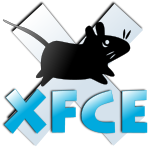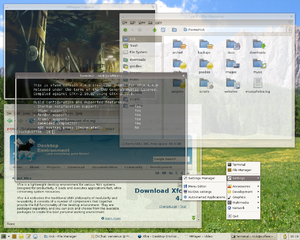- Xfce
-
Xfce 

A typical Xfce 4.4 desktop. Various Xfwm effects are visible (drop shadows behind windows, alpha-blended windows and panel).Developer(s) Multiple developers, enumerated here Stable release 4.8.0 / January 16, 2011 Development status Active Written in C (GTK+ 2) Platform Unix-like Type Desktop environment License GNU General Public License, GNU Lesser General Public License and BSD License Website http://www.xfce.org Xfce (pronounced as four individual letters)[1] is a free software desktop environment for Unix and other Unix-like platforms, such as Linux, Solaris, and BSD – though recent compatibility issues have arisen with regard to BSD Unix platforms.[2] It aims to be fast and lightweight, while still being visually appealing and easy to use.
The current version, 4.8, is meant to be modular and reusable[clarification needed] It consists of separately packaged components that together provide the full functionality of the desktop environment, but which can be selected in subsets to create the user's preferred personal working environment. Xfce is mainly used for its ability to run a modern desktop environment on relatively modest hardware.
It is based on the GTK+ 2 toolkit (the same as GNOME). It uses the Xfwm window manager, described below. Its configuration is entirely mouse-driven, and the configuration files are hidden from the casual user.
Xfce is included as one of the graphical user interfaces on the Pandora handheld gaming system.[3]
It is possible to run Xfce with 40MB of memory using Alpine Linux.[4] On Ubuntu, tests show that Xfce 4.6 has lower memory usage than GNOME 2.29 and KDE Plasma Desktop 4.4, but higher than LXDE 0.5.[5]
Contents
History
Olivier Fourdan started the project in 1996.[6] The name "Xfce" originally stood for "XForms Common Environment", but since that time Xfce has been rewritten twice and no longer uses the XForms toolkit. The name survived, but it is no longer capitalized as "XFCE", but rather as "Xfce". The developers' current stance is that the initialism no longer stands for anything specific. It has been nicknamed "Cholesterol Free Desktop Environment",[7][8] even in some of its man pages,[9] and this rendering is quite popular as the unofficial name in the community (about 17,400 Google hits as of November 2011 [1]).
First versions
Xfce began as a simple project created with XForms, meant to be a free Linux clone of CDE. Fourdan released the program, a simple toolbar, to ibiblio (then "SunSITE").[10]
Version 2
Fourdan continued developing the project, and in 1998, Xfce 2 was released with the first version of Xfce's window manager, Xfwm. He requested to have the project included in Red Hat Linux, but was refused because the project was based on XForms. Red Hat only accepted software that was open source and released under either a GPL compatible or BSD compatible license, but, at the time, XForms was closed source and free only for personal use.[10] For the same reason, Xfce was not in Debian before version 3. Xfce 2 was only distributed in Debian's contrib component.[11]
Version 3
In March 1999 Fourdan began a complete rewrite of the project based on GTK+, a non-proprietary toolkit whose popularity was increasing. The result was Xfce 3.0, which was licensed under the GNU GPL. Along with being based completely on free software, the project gained GTK+'s drag-and-drop support, native language support, and improved configurability. Xfce was uploaded to SourceForge.net in February 2001, starting with version 3.8.1.[12]
Version 4
In version 4.0.0, Xfce was upgraded to use the GTK+ 2 libraries. Changes in 4.2.0 included a compositing manager for Xfwm which added built-in support for transparency and drop shadows, as well as a new default SVG icon set.[13] In January 2007, Xfce 4.4.0 was released. This included the Thunar file manager, a replacement for Xffm. Support for desktop icons was added. Also, various improvements were made to the panel to prevent buggy plugins from crashing the whole panel.[14] In February 2009 Xfce 4.6.0 was released. This version had a new configuration backend, a new settings manager and a new sound mixer, as well as several significant improvements to the session manager and the rest of Xfce's core components.[15]
In January 2011, Xfce 4.8.0 was released. This version included changes such as the replacement of ThunarVFS and HAL with GIO, udev, ConsoleKit and PolicyKit, and new utilities for browsing remote network shares using several protocols including SFTP, SMB, and FTP. Window clutter was reduced by merging all file progress dialog boxes into a single dialog. The panel application was also rewritten for better positioning, transparency, item and launcher management. 4.8 also introduced a new menu plugin to view directories. The 4.8 plugin framework remains compatible with 4.6 plugins. The display configuration dialog in 4.8 supports RandR 1.2, detecting screens automatically and allowing users to pick their preferred display resolution, refresh rate and display rotation. Screens can be configured to either work in clone mode or being placed next to each other. Keyboard selection has become easier and more user-friendly. Also, the manual settings editor has been updated to be more functional.[16]
The 4.8 development cycle was the first to use the new release strategy formed after the "Xfce Release and Development Model" developed at the Ubuntu Desktop Summit in May 2009. A new web application was employed to make release management easier, and a dedicated Transifex server was set up for Xfce translators.[17] The project's server and mirroring infrastructure was also upgraded, partly to cope with anticipated demand following the release announcement for 4.8.
Applications
Xfce provides a development framework for applications. Other than Xfce itself, there are third-party programs which use the Xfce libraries, most notably the Mousepad text editor, Orage calendar and Terminal. One of the services provided to applications by the framework is a red banner across the top of the window when the application is running with root privileges warning the user that they could damage system files.
Other Xfce components include:
- Xfmedia, a xine-based media player for Xfce; unmaintained since November 2006 (version 0.9.2)
- Xfprint, a print manager
- Xfburn, a CD/DVD burner
Mousepad
Mousepad is based on the Leafpad text editor, is the Xfce default text editor and is developed by Erik Harrison and Nick Schermer. It was originally developed to provide printing support, which Leafpad lacked at that time.[18] There have been no new releases of Mousepad for some time.
Orage
Starting with version 4.4, Xfcalendar was renamed to Orage and several features were added. Orage has alarms and uses the iCalendar format, making it compatible with many other calendar applications. It also includes a panel clock plugin and an international clock application capable of simultaneously showing clocks from several different time zones.
Parole
Parole is a media player that is based on the GStreamer framework. It is developed by Ali Abdallah and is part of the Xfce Goodies.[19] It originally was only playlist based, but now includes an option to replace the entire playlist when opening a file for playing.[20]
Thunar
Main article: ThunarThunar is the default file manager for Xfce, replacing Xffm. It resembles GNOME's Nautilus and is designed for speed and a low memory footprint[21] as well as being highly customizable through plugins. Xfce also has a lightweight archive manager called Xarchiver, but this is not part of the core Xfce 4.4.0.[22] More recently, Squeeze has been started as an archive manager designed to integrate better into the Xfce desktop, though no further updates have been released since 24 February 2008.[23]
Xfwm
Starting with version 4.2, Xfwm integrates its own compositing manager.
See also
References
- ^ "Xfce FAQ". http://wiki.xfce.org/faq. Retrieved 2007-01-06.
- ^ "Xfce 4.8 on BSD flavors". http://gezeiten.org/post/2011/01/Xfce-4.8-on-BSD-flavors.
- ^ "XFCE icons are visible in this photo of a finished Pandora". http://en.wikipedia.org/wiki/File:PandoraFront.JPG.
- ^ https://kmandla.wordpress.com/2010/12/02/also-not-a-joke-xfce-on-39mb/
- ^ Larabel, Michael (2010-03-08). "Power & Memory Usage Of GNOME, KDE, LXDE & Xfce". Phoronix. http://www.phoronix.com/scan.php?page=article&item=linux_desktop_vitals&num=1. Retrieved 30 July 2011.
- ^ Then, Ewdison (6 February 2009). "Xfce creator talks Linux, Moblin, netbooks and open-source". SlashGear. http://www.slashgear.com/xfce-creator-talks-linux-moblin-netbooks-and-open-source-0633329/. Retrieved 5 February 2011.
- ^ "Xfce - openSUSE". http://en.opensuse.org/Xfce.
- ^ "xce - What is xfce". http://linux.about.com/cs/linux101/g/xfce.htm.
- ^ "man - xfce (1) - The Cholesterol Free Desktop Environment". http://www.digipedia.pl/man/doc/view/xfce.1/.
- ^ a b Jacobowitz, Norman (1999-07-01). "Interview with Olivier Fourdan". Linux Gazette. http://linuxgazette.net/issue43/jacobowitz.xfce.html. Retrieved 2007-01-31.
- ^ Debian xfce source package 3.4.0.20000513-1 changelog
- ^ "SourceForge.net Project Page". http://sourceforge.net/projects/xfce/. Retrieved 2007-01-31.
- ^ "Xfce 4.2.0 Changelog". http://www.xfce.org/documentation/changelogs/4.2.0. Retrieved 2007-01-31.
- ^ Meurer, Benedikt (2007-01-21). "A Visual Tour of Xfce 4.4.0". http://foo-projects.org/~benny/articles/xfce44-visual-tour.html. Retrieved 2007-01-31.
- ^ Xfce Development Team. "Xfce 4.6.0 Changelog". http://www.xfce.org/download/changelogs/4.6.0/. Retrieved 2011-01-16.
- ^ Xfce Development Team. "Xfce 4.6.0 Changelog". http://www.xfce.org/download/changelogs/4.8.0/. Retrieved 2011-01-16.
- ^ http://blog.xfce.org/category/transifex/
- ^ "Xfce - Mousepad". Xfce Project. http://www.xfce.org/projects/mousepad/. Retrieved 2009-02-22.
- ^ "Juste une parole (Xfce Goodies)". http://goodies.xfce.org/projects/applications/parole.
- ^ "parole - GStreamer based media player". http://git.xfce.org/apps/parole/commit/?id=61df0aef193f67047bf130e4adb13bff32eab4d9.
- ^ ThunarWiki: Thunar in comparison to Nautilus, ROX, Konqueror and Xffm
- ^ "4.4.0 release status so far". http://foo-projects.org/pipermail/xfce4-dev/2007-January/022198.html.
- ^ "Squeeze - news". http://squeeze.xfce.org/news.
External links
Desktop environments and window managers for X11 DEs Full-featuredGNOME • KDE Software CompilationMid-rangeCDE • IRIX Interactive Desktop • XfceLightweightShellUnity • GNOME Shell • KDE PlasmaWMs Full-featuredLightweightMinimalisticOperating systems that offer the Xfce desktop ALT Linux · Arch Linux · Debian · Dreamlinux · Dyne:bolic · Element OS · Fedora · FreeBSD · FreeSBIE · Gentoo Linux · Granular Linux · KateOS · Linpus Linux · Linux From Scratch · Linux Mint · Mandriva Linux · Mythbuntu · openSUSE · PC/OS · Puredyne · Salix · Sam Linux · sidux · Slackware · Slax · SystemRescueCD · SuperGamer · VectorLinux · Wolvix · Xubuntu · Zenwalk · ZevenOS
Window management topics Methods Tiling examples awesome · dwm · PWM · Ion · wmii · ratpoison · xmonad · Xerox Star · Windows 1.0 · GEM (2.0 and later)Stacking examples twm · cwm · mwm · FVWM · Enlightenment · Blackbox · Presentation Manager · Windows 2.0 · Windows 95 · Windows 98 · Windows Me · Windows NT (until Windows XP) · Mac OS 9 and earlier · GEM 1.1 · WindowLab · Xerox AltoCompositing examples Beryl · Compiz · Desktop Window Manager (with Windows Aero) · Metacity · Mutter · KWin · Aqua (with the Quartz Compositor)Systems with WMs Amiga OS · Mac OS · OS/2 · Xerox PARC (Xerox Alto, Xerox Star) · Microsoft Windows · Atari TOS · RISC OS · OpenVMSComponents Related reading Windowing system · Desktop environment · GUI widget · X Window System · X window manager · OpenGL · DirectX · GPU · Mouse · Keyboard · WIMP · GUI · Widget toolkit · Turbo Vision · Qt · GTK · AIGLX · XGL · Shell (computing) · Painter's algorithm · Resolution independenceCategories:- Free desktop environments
- X Window System
- MS Windows-like desktops
- Compositing window managers
Wikimedia Foundation. 2010.

